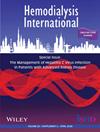Relationship between altered taste and smell with malnutrition among hemodialysis patients
Abstract
Introduction
Alterations in taste and smell are among the most distressing symptoms experienced by haemodialysis patients. There is limited research on the relationship between these two symptoms and malnutrition in haemodialysis patients. This study aimed to investigate alterations in taste and smell in hemodialysis patients and their relationship with malnutrition.
Methods
This cross-sectional study was carried out with 149 hemodialysis patients at the dialysis centers of three state hospitals. The Taste and Smell Dysfunction Questionnaire was used to assess the changes in patients' taste and smell, and the Prognostic Nutritional Index (PNI), as well as the Controlling Nutritional Status (CONUT) tool, were utilized to evaluate their nutritional status.
Findings
A substantial percentage (45.6%) of patients reported an altered sense of smell, and 40.2% reported an altered sense of taste. The aspect of taste that was most abnormal was bitterness (46.7%); 53.0% of the patients were at moderate risk of malnutrition by PNI score, and 14.8% were categorized as malnourished by CONUT score. Malnutrition was related to dialysis vintage: a 1-year increase in vintage was associated with an increased risk of malnutrition (OR: 1.17, 95% CI 1.02–1.32, p < 0.001). Altered taste was associated with malnutrition: one-unit increase in the standard deviation of the taste subdimension score was associated with a relative risk of malnutrition (OR: 6.89, 95% CI 1.67–28.39, p < 0.001). A one-unit increase in the standard deviation of the smell subdimension was associated with relative risk of malnutrition (OR: 1.35, 95% CI 1.10–1.64, p < 0.001).
Discussion
Malnutrition was found in a significantpercentage of hemodialysis patients. Altered taste and smell and the durationof dialysis treatment were significantly associated with malnutrition scores It isrecommended that healthcare professionals regularly assess alterations in tasteand smell in hemodialysis patients, as these alterations may be associated withmalnutrition, and manage these alterations accordingly.

 求助内容:
求助内容: 应助结果提醒方式:
应助结果提醒方式:


